
Academy 1/72 USAF F-35A Lightning II
By Chris Banyai-Riepl
Overview
The F-35 is supposed to be the best all-around multi-service fighter aircraft out there, being stealthy, maneuverable, and powerful. The reality has fallen short, though, and the program has been plagued by setbacks. By late 2011, a Pentagon study team found over a dozen areas of concern with the F-35, including the fuel dump subsystem posing a fire hazard, multiple thermal management issues, and classified survivability issues, most likely involving stealth (the aircraft was downgraded from very low observable to low observable in 2006). By 2013, the program still had major issues, including maintenance problems such as the engine replacement taking around 52 hours instead of the two hours originally specified. Still in its testing phase, the hope is to get the F-35 operational in the next few years, although the roadmap for development goes out to 2021.
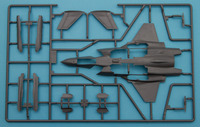 When everything works, though, the F-35 has the potential of being an excellent fighter. The internal weapon bays contain a total of four weapon stations, and can carry AMRAAMs, ASRAAMs, JDAMs, JSOWs, and lots of other acronyms. The Block 5 upgrade will increase the internal load from four stations to six, and other upgrades are planned to allow for up to eight GBU-39 SDBs. The aircraft incorporates extensive stealth technology, making it difficult to find, while the helmet-mounted sight allows for target engagement outside of line of flight. All of these features combine to make for a potent aircraft, and once the bugs are worked out it will make up a major part of US armed forces.
When everything works, though, the F-35 has the potential of being an excellent fighter. The internal weapon bays contain a total of four weapon stations, and can carry AMRAAMs, ASRAAMs, JDAMs, JSOWs, and lots of other acronyms. The Block 5 upgrade will increase the internal load from four stations to six, and other upgrades are planned to allow for up to eight GBU-39 SDBs. The aircraft incorporates extensive stealth technology, making it difficult to find, while the helmet-mounted sight allows for target engagement outside of line of flight. All of these features combine to make for a potent aircraft, and once the bugs are worked out it will make up a major part of US armed forces.
The Kit
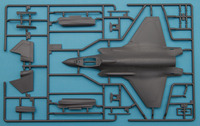 Academy is the most recent of F-35 kits to show up in 1/72, and on initial examination appears to be the best option out there. We still haven't seen a Hasegawa kit, though, so whether Academy will stay as the go-to kit for the F-35 remains to be seen. The kit comes molded in the new style of Academy, reminiscent of Matchbox kits of ages ago, with plastic in dark gray, light gray, white, and black, as well as the clear bits. The kit features recessed panel lines throughout, with plenty of interesting options. The decal sheet provides quite a few marking options, including stenciling.
Academy is the most recent of F-35 kits to show up in 1/72, and on initial examination appears to be the best option out there. We still haven't seen a Hasegawa kit, though, so whether Academy will stay as the go-to kit for the F-35 remains to be seen. The kit comes molded in the new style of Academy, reminiscent of Matchbox kits of ages ago, with plastic in dark gray, light gray, white, and black, as well as the clear bits. The kit features recessed panel lines throughout, with plenty of interesting options. The decal sheet provides quite a few marking options, including stenciling.
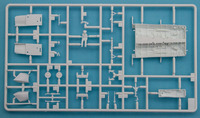 Diving into the construction, this kit is split into two main halves, an upper piece and a lower piece. In between these will go lots of bits, and it is here that the instructions start you out. The large weapon bay/main gear bay piece is molded in white, and fits into the lower fuselage. This piece incorporates part of the intake trunking, while the rest is made up from three additional inserts. While this completes the trunk, there is no engine face provided. I have not taped things together to check, but I am thinking that the engine face will not be visible anyway. There are a couple extra inserts to complete the main gear wells. Given the shape of all of those parts, it might be easier to pre-paint those white before assembly.
Diving into the construction, this kit is split into two main halves, an upper piece and a lower piece. In between these will go lots of bits, and it is here that the instructions start you out. The large weapon bay/main gear bay piece is molded in white, and fits into the lower fuselage. This piece incorporates part of the intake trunking, while the rest is made up from three additional inserts. While this completes the trunk, there is no engine face provided. I have not taped things together to check, but I am thinking that the engine face will not be visible anyway. There are a couple extra inserts to complete the main gear wells. Given the shape of all of those parts, it might be easier to pre-paint those white before assembly.
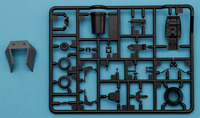 Moving on to the other inside bits, the cockpit is rather well done for an out of the box injection plastic assembly. The cockpit tub has raised detailing, and has separate control sticks for both side consoles. The seat is made up from eight pieces, and aside from seat belts, appears to be complete. Seat belts might not be needed, though, as the kit comes with a nicely detailed pilot figure. The completed seat and the instrument panel fit into the tub, and with the addition of decal instrument details, the finished tub can be attached to the top of the nose wheel well and inserted in the fuselage.
Moving on to the other inside bits, the cockpit is rather well done for an out of the box injection plastic assembly. The cockpit tub has raised detailing, and has separate control sticks for both side consoles. The seat is made up from eight pieces, and aside from seat belts, appears to be complete. Seat belts might not be needed, though, as the kit comes with a nicely detailed pilot figure. The completed seat and the instrument panel fit into the tub, and with the addition of decal instrument details, the finished tub can be attached to the top of the nose wheel well and inserted in the fuselage.
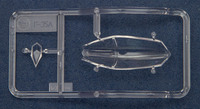 Once the interior bits are done, the upper and lower fuselage halves go together. This is split along some pretty logical seams, and it looks like the only place filler could be used is along the nose seam. If the kit fits well, though, you'll probably need little more than a bit of sanding and you're done. On the back side, the vertical fins and horizontal stabilizers are separate. The horizontal stabilizers have very large and positive attachment points, while the vertical fins are an interesting two-part assembly. These have a small bottom piece with a tab that fits into a slot in the upper fuselage, with the rest of the fin going on top of that. At first glance, it looks like this could be a very easy way to paint and detail the fins separately, thus avoiding some complex masking around some difficult corners.
Once the interior bits are done, the upper and lower fuselage halves go together. This is split along some pretty logical seams, and it looks like the only place filler could be used is along the nose seam. If the kit fits well, though, you'll probably need little more than a bit of sanding and you're done. On the back side, the vertical fins and horizontal stabilizers are separate. The horizontal stabilizers have very large and positive attachment points, while the vertical fins are an interesting two-part assembly. These have a small bottom piece with a tab that fits into a slot in the upper fuselage, with the rest of the fin going on top of that. At first glance, it looks like this could be a very easy way to paint and detail the fins separately, thus avoiding some complex masking around some difficult corners.
 With all of that together, the rest of the assembly is all the fiddly bits. The exhaust pipe comes in two pieces, and does a good job of capturing the look of the faceted burner can. The landing gear is well detailed and features some sturdy attachment points, so the finished model should sit well on the shelf. A nice addition in this kit are the underwing pylons, all six of them. These are nice, as the kit comes with stores for all of them, plus the internal bay. You get two AIM-9Xs, two AIM-120Cs, four GBU-38s, and two GBU-31(V)3s. For those who want a clean F-35, you'll have lots of fun stuff to toss in the spares box with this one.
With all of that together, the rest of the assembly is all the fiddly bits. The exhaust pipe comes in two pieces, and does a good job of capturing the look of the faceted burner can. The landing gear is well detailed and features some sturdy attachment points, so the finished model should sit well on the shelf. A nice addition in this kit are the underwing pylons, all six of them. These are nice, as the kit comes with stores for all of them, plus the internal bay. You get two AIM-9Xs, two AIM-120Cs, four GBU-38s, and two GBU-31(V)3s. For those who want a clean F-35, you'll have lots of fun stuff to toss in the spares box with this one.
Kicking it over to the paint booth, painting your F-35 is both simple and challenging. Simple, in that there's no random camouflage pattern to deal with. It's just solid colors. Challenging, because the solid colors have a metallic hint to them, and there's lighter colored panels all over this thing. The instructions suggest adding 10% silver to the paint in order to get that metallic sheen, and I'll give that a try. They offer no assistance on the lighter colored panels, though, and several of these have sawtoothed edges. Be ready for some fun masking on this one. Or, perhaps wait a bit and maybe Eduard will come out with a mask set for this plane.
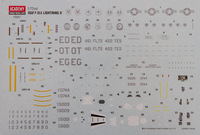 Once you have the paint on, it's time to look at the decals (and there's another idea, why didn't they provide some of those more complicated panels as decals?). There are three options provided on the sheet. First up is AF-06, 07-0744, from the 461st Flight Test Squadron, 412th Test Wing, at Edwards AFB. This aircraft has the tail code of ED, with 461 FLTS on the tail. Second is AF-14, 09-5001, 58th Fighter Squadron, 33rd Fighter Wing, at Eglin AFB. This plane carries EG tail codes. Finally, we have AF-21, 10-5009, from the 422nd Test and Evaluation Squadron, 53rd Wing, at Nellis AFB. This plane has OT tail codes and 422 TES on the tail. The decals include stenciling and data plates for both the aircraft and the weapons.
Once you have the paint on, it's time to look at the decals (and there's another idea, why didn't they provide some of those more complicated panels as decals?). There are three options provided on the sheet. First up is AF-06, 07-0744, from the 461st Flight Test Squadron, 412th Test Wing, at Edwards AFB. This aircraft has the tail code of ED, with 461 FLTS on the tail. Second is AF-14, 09-5001, 58th Fighter Squadron, 33rd Fighter Wing, at Eglin AFB. This plane carries EG tail codes. Finally, we have AF-21, 10-5009, from the 422nd Test and Evaluation Squadron, 53rd Wing, at Nellis AFB. This plane has OT tail codes and 422 TES on the tail. The decals include stenciling and data plates for both the aircraft and the weapons.
Conclusion
This is a very good looking kit, and it will be challenging for Hasegawa to surpass this one as THE F-35A kit to get. Hopefully Academy will do the other variants as well, so we can see some Navy or foreign options in the near future. For those who want an F-35 now, though, this is definitely one to look closely at. My thanks to MRC for the review sample.
